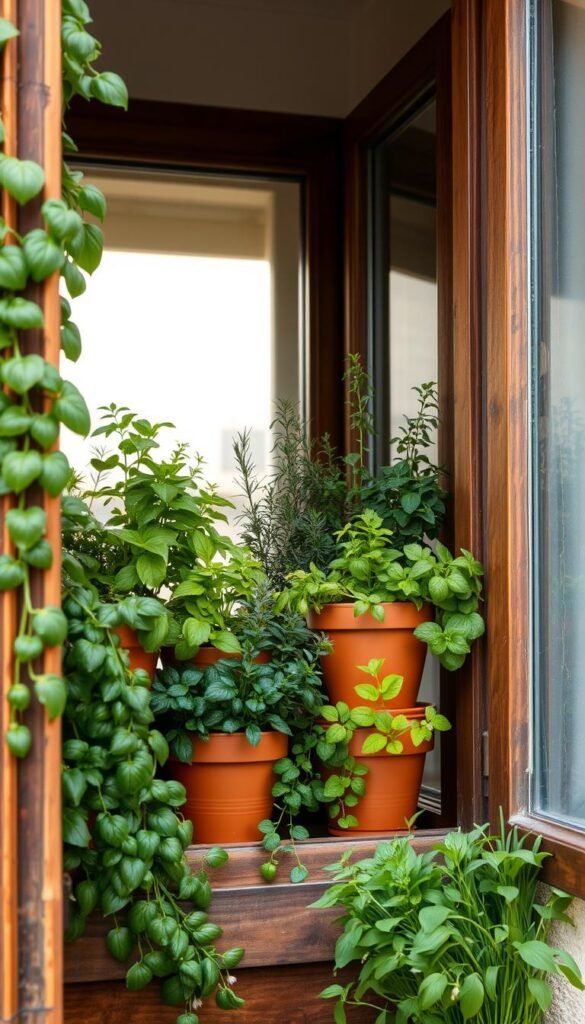Imagine snipping fragrant basil leaves for your pasta or adding homegrown mint to your iced tea—all without stepping outside. Urban living doesn’t mean sacrificing fresh ingredients. A sunny windowsill and a simple container can transform your kitchen into a thriving green space.
Window boxes aren’t just for flowers. They’re perfect for growing herbs in tight quarters, offering quick access to flavors that elevate meals. No backyard? No problem. These compact setups fit seamlessly into apartments, adding both practicality and charm to your home.
Why choose this approach? Container gardening requires minimal effort. You control the soil quality and water levels, reducing guesswork. Plus, aromatic plants like thyme and oregano double as natural air fresheners. Their vibrant greenery brightens rooms while keeping dinner recipes exciting.
Experts recommend starting with varieties that adapt well to limited space. Hardy options like rosemary or parsley thrive in small pots, yielding fresh picks year-round. Whether you’re garnishing soups or crafting cocktails, having live plants nearby makes every dish taste fresher.
Ready to begin? This guide walks through selecting the right containers, optimizing sunlight, and troubleshooting common issues. You’ll discover how to turn that empty windowsill into a productive—and beautiful—spot for culinary creativity.
Why Growing Herbs in Your Apartment Window Box Works Wonders
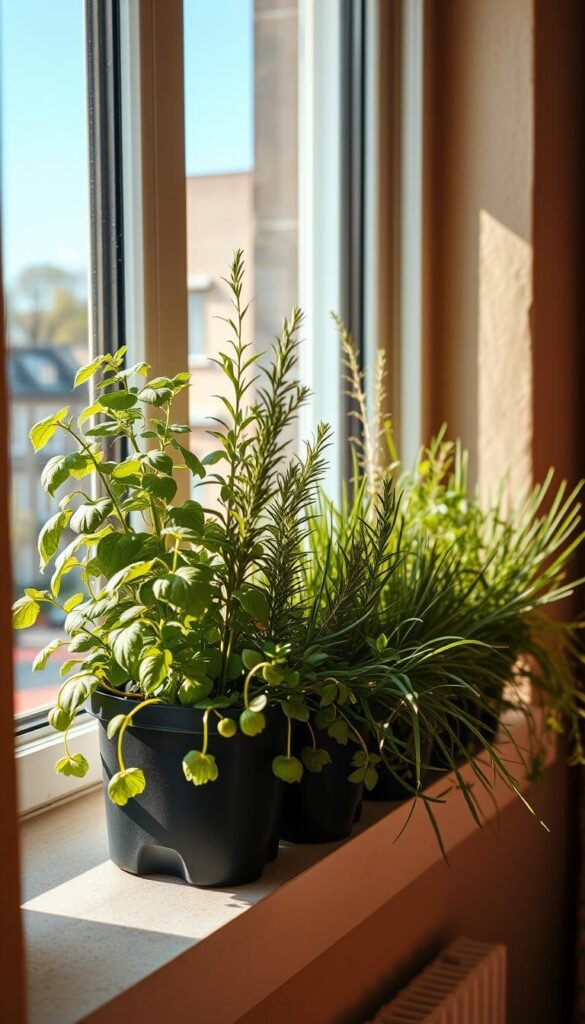
Urban gardening unlocks flavor-packed possibilities right where you live. With container gardening, even a narrow ledge becomes a productive space for herbs that transform everyday meals. Let’s explore how this approach simplifies your life while adding natural beauty to your home.
Advantages of Container Gardening
Growing herbs in containers lets you maximize every inch. Unlike traditional gardens, you can position plants where they’ll thrive—no wrestling with poor outdoor soil. Elevating your window box keeps slugs and rabbits at bay while making it easier to snip sprigs mid-recipe.
| Feature | Container Gardening | Traditional Gardening |
|---|---|---|
| Space Needed | Fits windowsills | Requires yards |
| Pest Control | Elevated protection | Ground exposure |
| Maintenance | Low effort | Weeding required |
Quality soil matters most. Use lightweight potting mixes designed for drainage—this prevents root rot. Busy schedule? Self-watering pots or drip trays reduce daily chores.
Enhancing Your Home’s Curb Appeal
Stylish planters add personality to your space. Choose colorful ceramic pots or sleek metal boxes that complement your decor. As your herbs flourish, they create a living decoration that smells as good as it looks.
Ready to start? Pick best herbs like basil or thyme—they adapt well to pots. Soon, you’ll enjoy fresh herbs daily while impressing neighbors with your green thumb. Keep reading to design your perfect setup!
Planning and Setting Up Your Small Urban Herb Garden
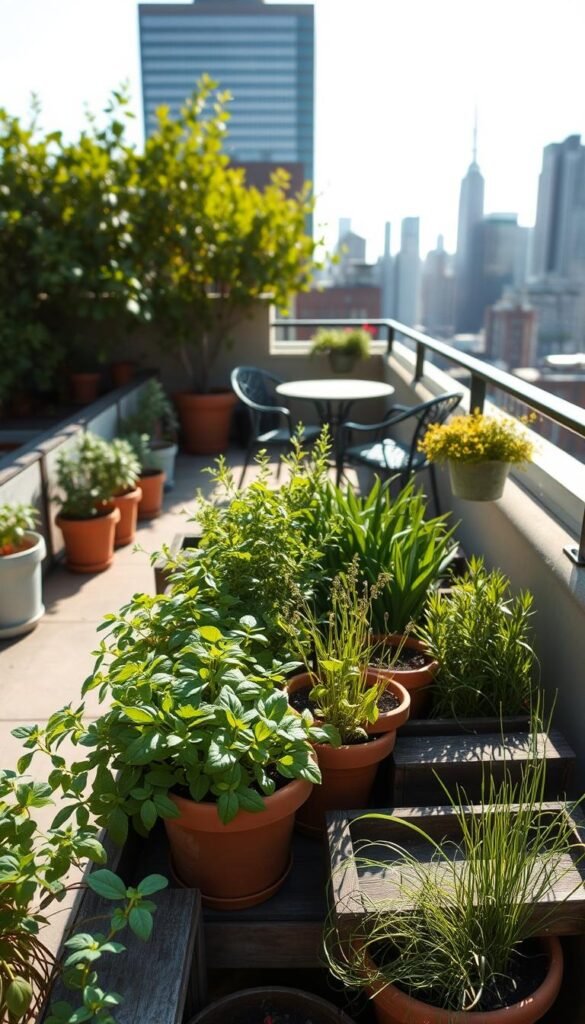
Creating a thriving herb garden starts with smart preparation. Focus on three essentials: containers, soil, and sunlight. A thoughtful setup ensures your plants grow vigorously, even in tight space.
Selecting the Perfect Containers
Choose pots that match your herbs’ needs. Drainage holes prevent waterlogged roots—add pebbles at the bottom for extra protection. Shallow-rooted herbs like thyme thrive in 6-inch-deep containers, while basil needs a larger pot (10+ inches).
| Material | Pros | Cons |
|---|---|---|
| Terracotta | Breathable, classic look | Heavy, dries quickly |
| Plastic | Lightweight, affordable | Less durable |
| Metal | Modern style | Can overheat roots |
Use nutrient-rich soil blended with perlite for drainage. Overcrowding stifles growth—give each plant 4-6 inches of space. Start small: sow 2-3 seeds per pot and thin weaker sprouts later.
Finding the Best Spot for Sunlight
Most herbs crave 6+ hours of daily sunlight. South-facing windows work best. If yours has double-glazed glass, open it occasionally or use a reflective tray to boost light. Rotate pots weekly for even growth.
Struggling with dim areas? Hardy herbs like chives tolerate partial shade. Track sun patterns for a week before planting—adjust your layout to match.
Top 5 Herbs to Grow in an Apartment Window Box
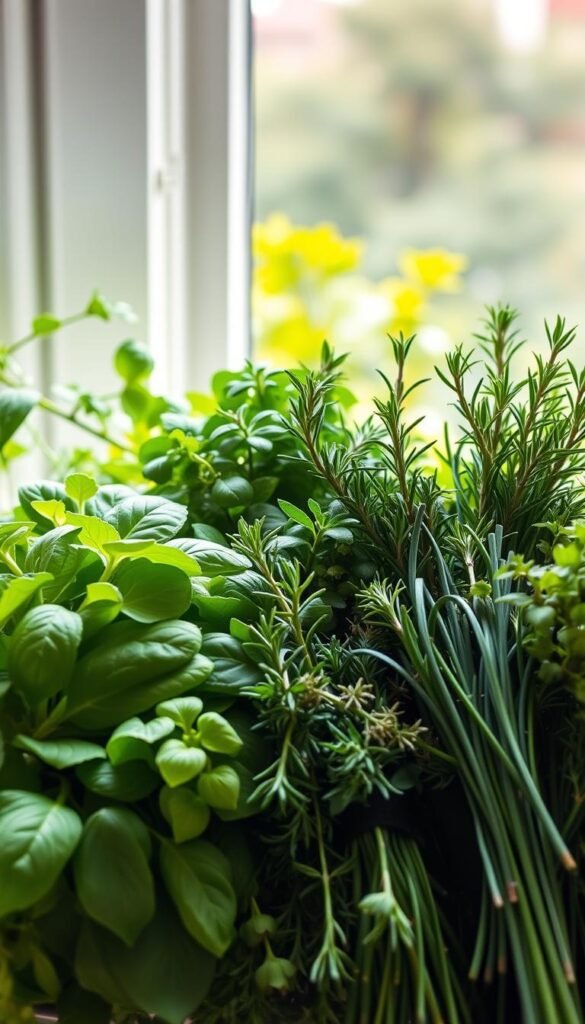
Your culinary adventures get a flavor boost with these five superstar plants. Perfect for small-space gardening—like balcony setups—they thrive in containers while delivering fresh tastes daily. Let’s meet your new kitchen allies!
Flavor Powerhouse: Basil
Basil brings warmth to pesto, salads, and pasta. Snip leaves from the top to encourage bushier growth. Keep soil moist but not soggy—this sun-loving herb craves 6+ hours of light.
Mood-Lifting Mint
Mint thrives in pots (it’s a spreader!). Add sprigs to lemonade or chop into tabbouleh. Trim regularly to prevent leggy stems. Partial shade works if your window gets afternoon glare.
Compact Rosemary
This woody herb loves tight quarters. Use well-draining soil and water only when dry. Run fingers through its needles to release aroma into roasted veggies or bread.
Easy-Going Chives
Chives grow almost anywhere. Snip their onion-like stems over baked potatoes or soups. Divide clumps every spring to keep them productive.
Low-Key Thyme
Thyme survives occasional neglect. Harvest sprigs for stews or infused oils. Prune after flowering to maintain its tidy shape.
Having these fresh herbs right on your windowsill means impromptu garnishes and richer flavors. Try one—or all five—to discover which favorite herbs elevate your cooking style!
Caring for Your Herbs on a Windowsill
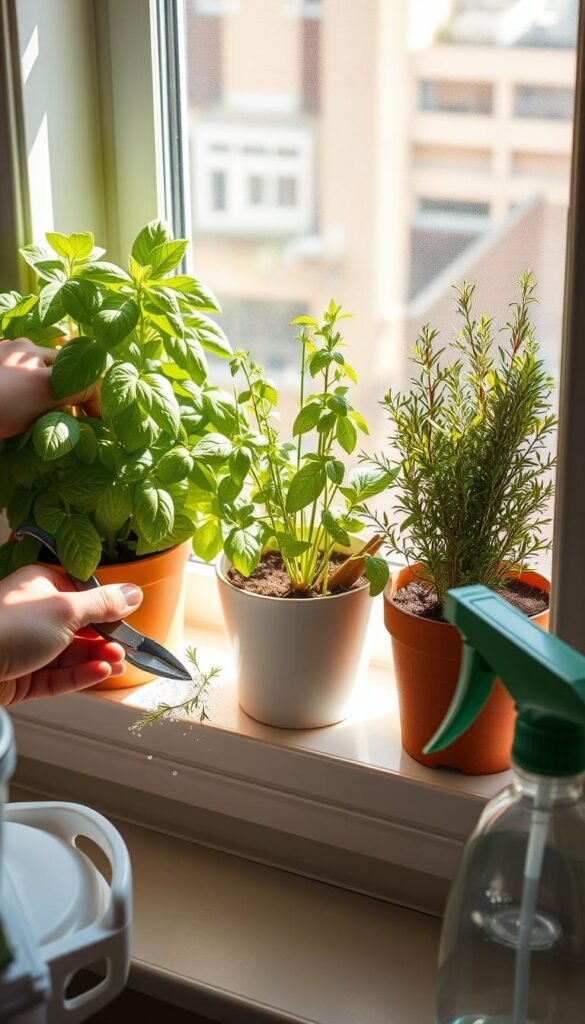
Keeping your windowsill herbs thriving is simpler than you think—if you master a few key routines. Focus on balancing water, nutrients, and timely trims. This combo keeps plants lush and productive, even in cozy indoor spaces.
Watering, Drainage, and Soil Nutrients
Check soil moisture daily by sticking your finger an inch deep. If it feels dry, give a thorough drink—but never let pots sit in excess water. Use containers with drainage holes and empty trays promptly to protect roots.
| Issue | Solution | Signs of Success |
|---|---|---|
| Overwatering | Wait until topsoil dries | Firm, white roots |
| Underwatering | Soak until water drains freely | Perky leaves |
| Nutrient Lack | Add compost every 6 weeks | Vibrant growth |
Mix perlite into potting soil for better airflow. Herbs like basil need a lot of nitrogen—try coffee grounds as a natural fertilizer. Refresh soil yearly to prevent compaction.
Tips for Pruning and Harvesting
Trim stems just above leaf nodes to encourage bushier growth. For basil, pinch off flower buds to redirect energy into leaf production. Harvest mint by cutting ⅓ of each stem, rotating which sections you take.
Morning is best for picking—plants are hydrated, ensuring peak flavor. Always leave at least 4-6 leaves intact so they can photosynthesize. With regular care, your kitchen stash stays fresh all year!
Essential Tips for a Thriving Container Herb Garden
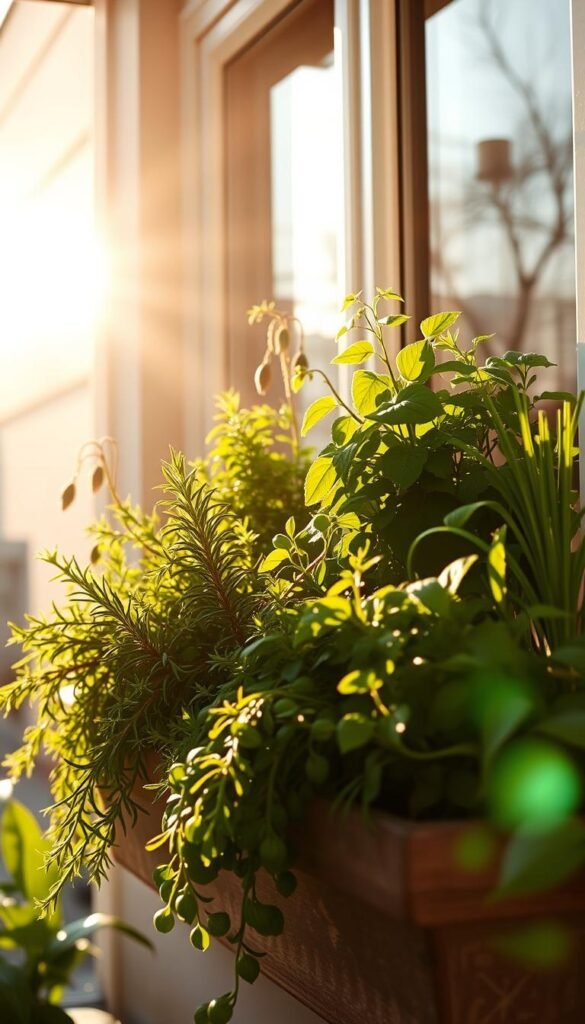
Maximizing your windowsill’s potential starts with smart space and light strategies. Even the coziest spots can yield abundant harvests when you balance container choices with clever arrangements. Let’s turn that sunny nook into a lush, productive corner.
Smart Container Selection for Tight Quarters
Pick small pots with depth matching your herbs’ roots. Shallow containers suit thyme or oregano, while deeper ones support basil. Ensure drainage holes prevent soggy soil—add gravel at the bottom for extra protection.
| Pot Type | Best For | Sunlight Flexibility |
|---|---|---|
| Stackable Planters | Vertical growth | Adjustable tiers |
| Window Boxes | Multiple plants | Full-sill exposure |
| Hanging Baskets | Trailing herbs | Angled light capture |
Group small herb varieties like chives and parsley in clustered arrangements. This way, you create a small herb garden without overcrowding. Rotate pots weekly to ensure even light distribution.
Sunlight Hacks for Urban Spaces
South-facing windows work best, but reflective trays boost dim areas. If double-glazed glass filters light, crack the window open during peak hours. Track daily patterns—move pots to follow the sun’s path.
Stagger taller plants behind shorter ones to prevent shading. Use wall-mounted shelves for trailing varieties like mint. With thoughtful placement, your herbs right at hand will thrive while adding greenery to your view.
Adapting Herb Care to Limited Outdoor and Indoor Spaces
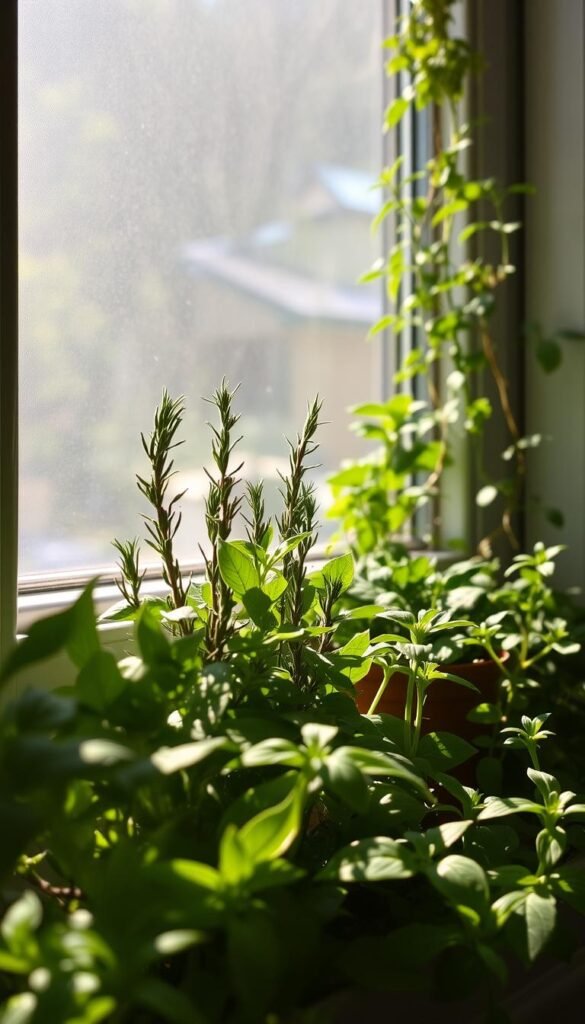
Don’t let dim corners or cloudy days dampen your herb-growing dreams. Limited light doesn’t mean you can’t enjoy fresh flavors—it just calls for clever adjustments. With a few tweaks, even shady spots can nurture thriving plants.
Maximizing Light in Tight Quarters
Rotate your herbs outdoors when temperatures allow. A sunny balcony or patio gives them a boost of natural light and fresh air. Just acclimate plants gradually to prevent sunburn on delicate leaves.
No outdoor access? Position pots near south-facing windows. Use mirrors or aluminum foil behind containers to reflect available light. For stubbornly dark areas, try full-spectrum grow lights—2-4 hours daily keeps mint and rosemary perky.
| Indoor Challenges | Outdoor Benefits |
|---|---|
| Weak stems | Stronger growth |
| Slow harvests | Faster leaf production |
| Pale leaves | Deeper color |
Choose compact varieties like thyme or chives that tolerate lower light. Their resilience makes them ideal for small space setups. Keep soil slightly drier indoors—overwatering worsens light-related stress.
Watch for leggy stems or yellowing leaves. These signs mean your herb garden needs more brightness. Shift containers weekly to track sunlight patterns, and trim overcrowded branches to improve airflow.
With these strategies, your herbs can flourish year-round. Even a modest container near a window becomes a source of vitality. Experiment until you find what works best for your home—every ray of light counts!
Unleashing Creative Culinary Ideas with Fresh Herbs
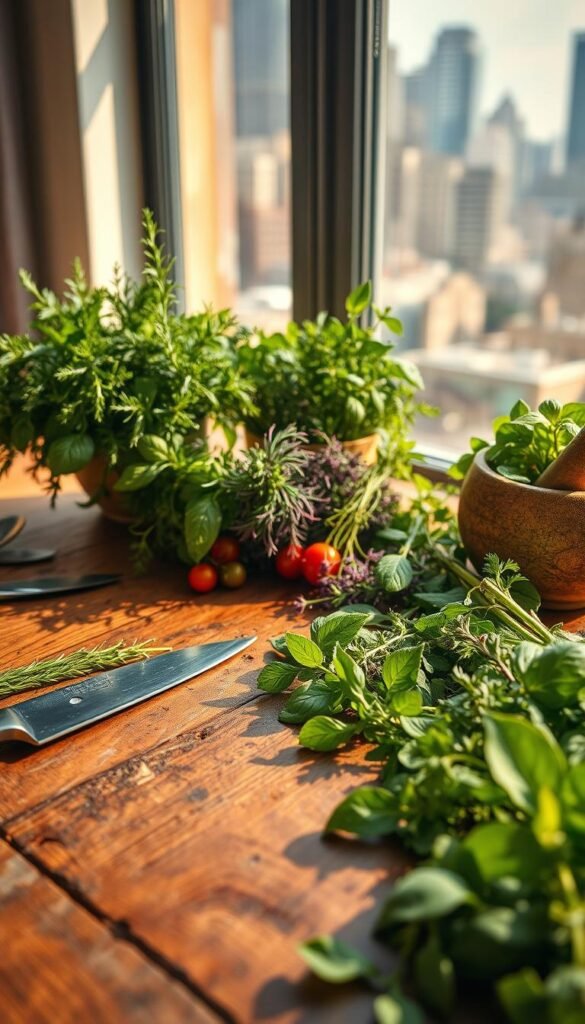
Transform everyday meals into gourmet experiences with herbs snipped straight from your windowsill. Their vibrant flavors turn simple food into memorable dishes, whether you’re cooking for one or hosting friends.
Mixing Flavors in Your Kitchen
Pair mint with watermelon salads or muddle it into mojitos for a refreshing twist. Add basil leaves to caprese sandwiches or blend into creamy pesto. For savory depth, sprinkle rosemary over roasted potatoes or infuse olive oil with thyme.
| Herb | Best Pairings | Flavor Tip |
|---|---|---|
| Chives | Eggs, soups, dips | Add raw for mild onion kick |
| Thyme | Stews, poultry, bread | Use whole sprigs + remove stems |
| Rosemary | Lamb, focaccia, lemonade | Chop finely to avoid toughness |
Incorporating Herbs into Seasonal Recipes
Celebrate summer with herb-infused cocktails: basil gin fizzes or lavender lemonade. In fall, toss thyme into butternut squash soup. Winter calls for rosemary-rubbed roasts, while spring shines with chive-studded deviled eggs.
Create signature dishes like mint-pea risotto or thyme-honey glazed carrots. Let your herb garden inspire variety dishes—every season offers new combinations. Clip fresh herbs right before cooking to lock in their aromatic oils.
Final Thoughts on Cultivating Your Apartment Herb Garden
Your journey to fresh flavors starts with a single pot. Growing herbs in your kitchen window blends practicality with joy—transforming meals while adding life to your home. With smart small pots and attentive care, even tight spaces yield vibrant results.
Remember: healthy roots thrive in well-draining soil, and sunlight fuels growth. Rotate containers weekly for even exposure. Trim regularly to encourage bushier herbs plant shapes. Whether you’re seasoning soups with basil or garnishing drinks with mint, each snip connects you to nature’s rhythm.
Experiment freely. Swap containers, try herbs like rosemary or thyme, and adjust watering routines. Every tweak teaches you more about your green companions. Soon, your garden becomes a dynamic part of daily life—a fragrant reminder that growth happens in small, intentional steps.
Embrace the process. Those lively leaves prove that fresh flavors and natural beauty belong in every home. Your windowsill oasis awaits—ready to inspire your next culinary adventure.

